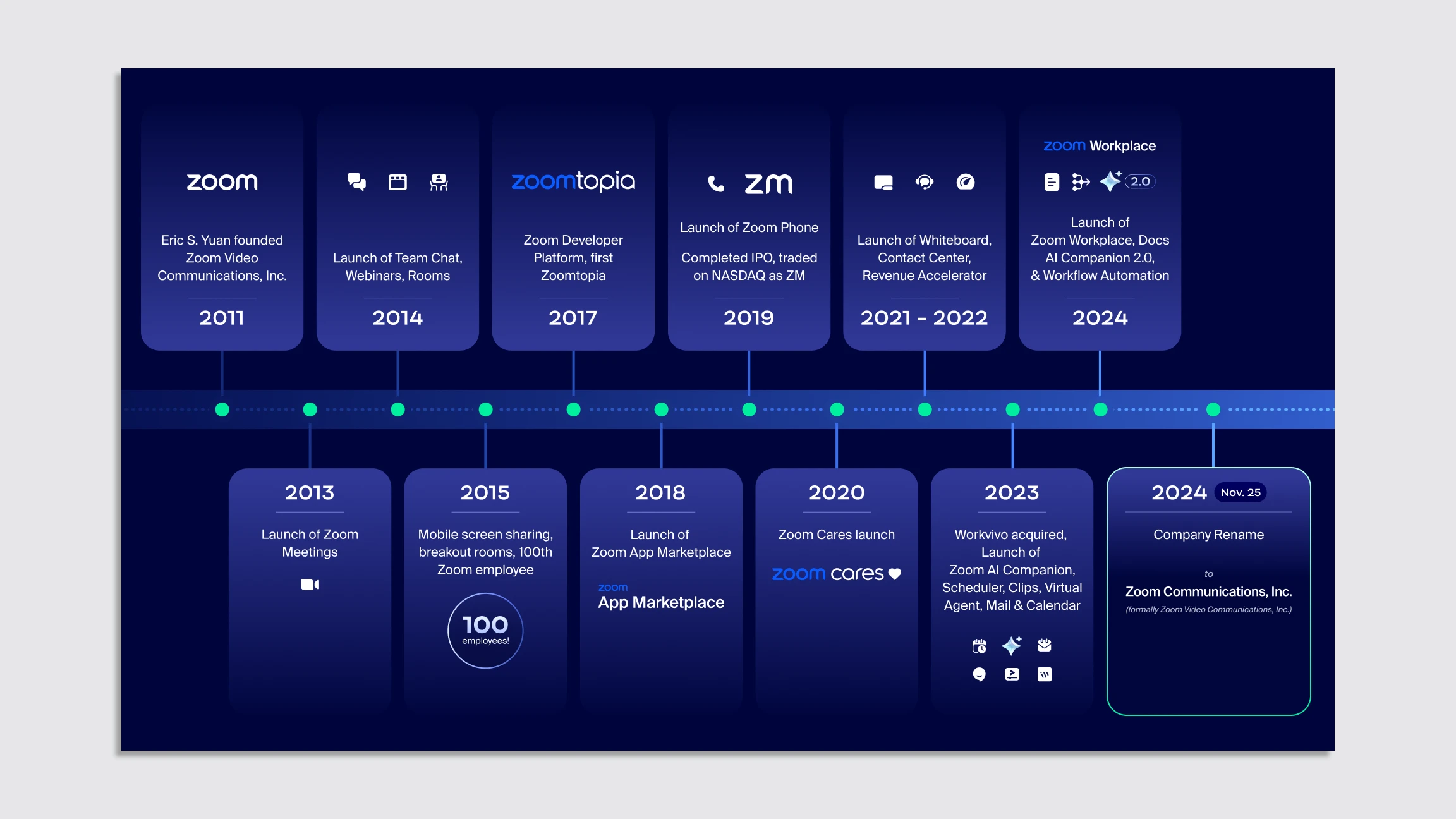Zoom just rebranded itself to Zoom
Zoom just announced that it’s changing its name. But its users will still call it Zoom. In a blog post published Monday, Zoom CEO Eric Yuan announced that the company formerly known as “Zoom Video Communications Inc.” will now simply be called “Zoom Communications Inc.” The rename seems almost negligible, given that the company is hardly ever actually referred to by its full title, with users preferring the colloquial name “Zoom.” (Its logo uses the concise version, too.) And while the change won’t alter how the company’s branding looks or sounds, it is significant for a different reason. Zoom rose to prominence during the pandemic as a video calling tool to hold virtual meetings with colleagues, family, and classmates. Now, though, the company wants to reposition itself as an “AI-first work platform,” or a catch-all workplace productivity site—think an AI-driven combination of Notion, Google Docs, and Microsoft Teams. The first step was dropping “video” from its name altogether. [Image: Zoom] What to expect from Zoom 2.0 Zoom was founded by Yuan as a video conferencing app back in 2011. But the company truly boomed when the pandemic shut down in-person meetings, with usage of the platform skyrocketing by 1,900% between December 2019 and September 2020. Since that period of take-off, Zoom’s finances have leveled off—though the company’s performance has proved to be better than expected in the second and third quarters of 2024. To compete with rival giants like Microsoft and Google, which each tout their own meeting services and AI workplace tools (Copilot and Duet AI, respectively), Zoom is pivoting away from its video-forward identity and highlighting its new AI capabilities, like the AI Companion it released in September 2023, which can summarize meetings, draft chat threads, and even help create visual whiteboards. (Zoom released a more advanced version 2.0 in October.) The company released Zoom Docs, a kind of Google Docs competitor with built-in AI features like section suggestions and summarization capabilities, a month later. “To deliver on our mission over the long-term, we must stay ahead of trends, innovate rapidly, and develop solutions that reflect our customers’ biggest needs—which we see as going far beyond video in the future of work,” Yuan wrote in his blog post yesterday. “This is most evident in the AI explosion that has disrupted the workplace over the past year.” And Zoom wants a piece of it. Pivot from video Aside from yesterday’s name tweak, the company has yet to introduce any branding changes to usher in this new era (or “Zoom 2.0,” as Yuan terms it). At a conference last year, Zoom’s EMEA chief Frederik Maris told Insider, “Our logo and our brand—it’s a blessing and a curse because everybody knows Zoom, but everybody knows us only for meetings.” He added: “Now we are becoming a completely different company.” Zoom’s main challenge at the moment is to spread the word about its existing AI capabilities. In the future, though, Yuan has some much loftier goals for its AI tools. “Over time, we believe these capabilities will translate into a fully customizable digital twin equipped with your institutional knowledge, freeing up a whole day’s worth of work and allowing you to work just four days per week,” Yuan wrote in the blog post. What’s a “digital twin,” you might ask? Earlier this year, Yuan gave a more in-depth explanation of the company’s dystopian concept in an interview on Decoder, a podcast produced by The Verge. Essentially, Yuan imagines a future where every Zoom user will have a kind of digital avatar who can attend meetings, speak for them, and make decisions in their stead. We aren’t there yet, but Yuan expects that the “digital twin” concept could come to fruition within the next few years. In the meantime, we’ll just have to keep attending Zoom meetings ourselves—or reading the AI summary.

Zoom just announced that it’s changing its name. But its users will still call it Zoom.
In a blog post published Monday, Zoom CEO Eric Yuan announced that the company formerly known as “Zoom Video Communications Inc.” will now simply be called “Zoom Communications Inc.” The rename seems almost negligible, given that the company is hardly ever actually referred to by its full title, with users preferring the colloquial name “Zoom.” (Its logo uses the concise version, too.) And while the change won’t alter how the company’s branding looks or sounds, it is significant for a different reason.
Zoom rose to prominence during the pandemic as a video calling tool to hold virtual meetings with colleagues, family, and classmates. Now, though, the company wants to reposition itself as an “AI-first work platform,” or a catch-all workplace productivity site—think an AI-driven combination of Notion, Google Docs, and Microsoft Teams. The first step was dropping “video” from its name altogether.

What to expect from Zoom 2.0
Zoom was founded by Yuan as a video conferencing app back in 2011. But the company truly boomed when the pandemic shut down in-person meetings, with usage of the platform skyrocketing by 1,900% between December 2019 and September 2020. Since that period of take-off, Zoom’s finances have leveled off—though the company’s performance has proved to be better than expected in the second and third quarters of 2024.
To compete with rival giants like Microsoft and Google, which each tout their own meeting services and AI workplace tools (Copilot and Duet AI, respectively), Zoom is pivoting away from its video-forward identity and highlighting its new AI capabilities, like the AI Companion it released in September 2023, which can summarize meetings, draft chat threads, and even help create visual whiteboards. (Zoom released a more advanced version 2.0 in October.) The company released Zoom Docs, a kind of Google Docs competitor with built-in AI features like section suggestions and summarization capabilities, a month later.
“To deliver on our mission over the long-term, we must stay ahead of trends, innovate rapidly, and develop solutions that reflect our customers’ biggest needs—which we see as going far beyond video in the future of work,” Yuan wrote in his blog post yesterday. “This is most evident in the AI explosion that has disrupted the workplace over the past year.” And Zoom wants a piece of it.
Pivot from video
Aside from yesterday’s name tweak, the company has yet to introduce any branding changes to usher in this new era (or “Zoom 2.0,” as Yuan terms it). At a conference last year, Zoom’s EMEA chief Frederik Maris told Insider, “Our logo and our brand—it’s a blessing and a curse because everybody knows Zoom, but everybody knows us only for meetings.” He added: “Now we are becoming a completely different company.”
Zoom’s main challenge at the moment is to spread the word about its existing AI capabilities. In the future, though, Yuan has some much loftier goals for its AI tools.
“Over time, we believe these capabilities will translate into a fully customizable digital twin equipped with your institutional knowledge, freeing up a whole day’s worth of work and allowing you to work just four days per week,” Yuan wrote in the blog post.
What’s a “digital twin,” you might ask? Earlier this year, Yuan gave a more in-depth explanation of the company’s dystopian concept in an interview on Decoder, a podcast produced by The Verge. Essentially, Yuan imagines a future where every Zoom user will have a kind of digital avatar who can attend meetings, speak for them, and make decisions in their stead.
We aren’t there yet, but Yuan expects that the “digital twin” concept could come to fruition within the next few years. In the meantime, we’ll just have to keep attending Zoom meetings ourselves—or reading the AI summary.






















